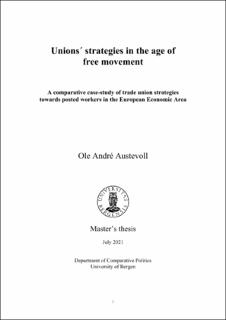Unions´ strategies in the age of free movement A comparative case-study of trade union strategies towards posted workers in the European Economic Area
Master thesis

View/
Date
2021-07-02Metadata
Show full item recordCollections
- Master theses [111]
Abstract
Numerous studies have concentrated on the consequences of intra-EU labour mobility. However, the literature lacks an analytical understanding of the types of strategies unions pursue and their relative usage. This thesis aims to reduce this knowledge gap by developing an analytical framework and connecting it with updated evidence from the German and Norwegian construction sectors. This thesis investigates the following research question: “What have been the dominant strategies used by trade unions in Germany and Norway in response to the wage competition from EU posted workers in the construction sector?” The timeframe of the research is from 2010 to 2020. The main findings are that unions in Germany and Norway have tried to restrict posted workers´ access to the construction sector by lobbying for legislation and industrial agreements that raise the cost for firms employing posted workers. At the same time, Norwegian unions have introduced agreements with the employers that ensure equal wages between posted and host workers in large construction projects. German unions have been less successful regarding this. Unions in Germany have offered posted workers political support through consultancy centres provided by unions. In contrast, Norwegian unions have had limited contact with posted workers. Unions in both countries indicate that the regional and local governments have been the primary political area for directing their exclusionist strategies. The results suggest that future research on trade unions in political science should focus more on the intermediate analysis level of regional governments.